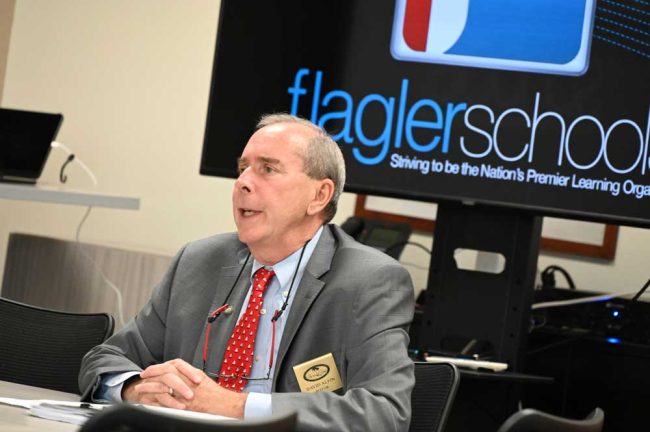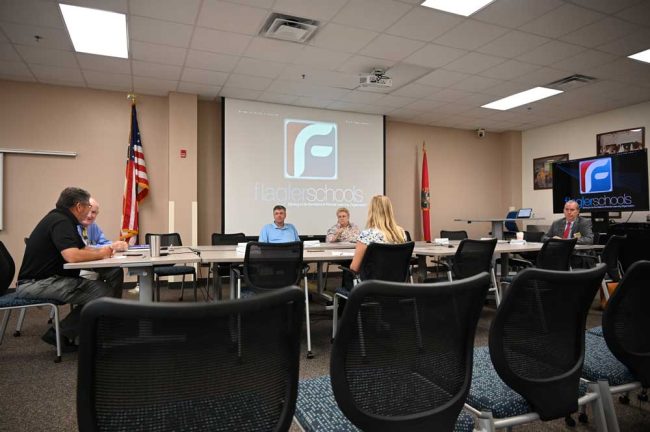
There were so many indications before this morning’s meeting that the nearly year-long battle over between the Flagler County school district and other local governments was over. The long-sought agreement between all the sides was inked, it had everyone’s agreement, it only needed a few dits and a formal ratification by each government, all of which is expected over the next few weeks.
This morning’s meeting of the so-called ILA (or inter-local agreement) Oversight Committee was itself almost a formality. It was the least attended of recent such meetings, whether by elected officials, staffers or audience members, including special interests–that is, builders, developers, their lawyers or advocates.
The district fought to ensure that development doesn’t overrun the capacity of schools to accommodate it, while county government, aided by Palm Coast and Bunnell (but not Flagler Beach), sought to lower cautionary barriers to development–barriers required by what’s referred to as school concurrency in state law: essentially, that residential developments should not be built if there isn’t enough space in existing schools to accommodate the new students those developments bring.
To ward off such a possibility, developers are required to ensure that the district has the money to build schools ahead of time and be ready to accommodate the in-flow of new students. But required to what degree? According to what timetable? When a district is at capacity, developers and builders pay fees sooner than they otherwise would, to defray the cost of new school construction (the fees are then deducted from their school impact fees).
The district wanted them to pay more fees at a quicker pace. The county and Palm Coast wanted them to pay fewer fees, over a longer period of time, stretching over years. The district argued it did not have that kind of time luxury. The county, essentially channeling the will of developers, argued that it was unfair to make builders and developer pay so much of their fees so far ahead of construction, hurting their cash flow. Palm Coast government argued that the cash flow issue may not impact big developers, but the city was interested in protecting the interests of smaller, local developers, who could be driven out of business from onerous cash flow burdens.
Plus there was the debate over student numbers. The district’s population has been flat for a decade and a half. Until this year, that hadn’t changed, lending developers to argue that the district was creating too dire a scenario of schools at or over capacity, and that its projections of needing a new high school and a new middle school by the middle of the decade was not based on verifiable trends. The district argued otherwise, and said it did not want to have to line school campuses with portable buildings (even though it’s beginning to do exactly that).

That’s where the battle lines were drawn and where the district and the other governments couldn’t agree, month after month, to the point that an impasse was reached in July. The risk became very real that the district could put a halt to several new planned developments, since state law grants it the power to withhold signing off on new developments if it determines that the development would bring students it could not presently accommodate.
Then Trevor Tucker, the chairman of the school board, offered a compromise that made no one particularly jubilant–an indication that he was onto something: a compromise nobody loved, but everyone would sign onto. All the sides did. The agreement calls for those up-front fees some developers would be required to pay–called mitigation payments–to be equal to 30 percent of what they owe to be paid within 60 days of their development being platted, 30 percent to be paid at the development’s 21-month mark, and 30 percent paid at the 42-month mark.
Keep in mind: this isn’t money the developers pay as a favor. They’re required to pay impact fees regardless, the one-time fees that are similar to a tax and that are intended to defray the cost of a development’s “impact” on schools, roads, parks, fire services and so on. Since most residential homes bring new children, and therefore students, most pay school impact fees (as shops and factories and doctors’ offices do not). The impact fees are paid at permitting time regardless. But when a developer pays up-front fees to ensure concurrency, those up-front fees are credited to what the developer would owe in impact fees.
Every local government involved ratified the new schedule, sending the matter back to the so-called Interlocal Agreement Oversight Committee to finalize. (The “interlocal agreement” is the document that spells out all the details, the rules, the schedules, the percentages and the responsibilities of all sides involved in the school concurrency system).
It’s also not a small matter that the more combative elected officials who’d contributed the most guns and ammo to the clash–namely, the county’s Joe Mullins and the school board’s Janet McDonald–lost their bids to stay in public office at the Aug. 23 primary, both of them by crushing margins. That sent a message: policy-making by antagonism, a tactic of both those officials, was rebuked. The difference at today’s meeting was palpable.
It was that ILA Oversight Committee that was meeting this morning, and where all indications were that the problem was solved. Palm Coast Mayor David Alfin, who chairs the committee and was himself in a cheery mood despite a challenging stretch at the City Council, pointed to the surest indication before the meeting: three smiling lawyers arrayed next to each other at a working table–Assistant County Attorney Sean Moylan, Palm Coast City Attorney Neysa Borkert, and School Board attorney Christ Wilson. They were among the superheroes of the effort, along with other administrative staffers. “The legal team has shown us a good example of how much you can accomplish when you collaborate and work together,” Alfin said. “We appreciate your efforts very, very much.”
Most of those efforts were seen by the public or the oversight committee, except in their final form. Even as they faithfully (if not forcefully) advocated for their respective governments, the lawyers worked as a remarkably productive unit, their analytical clarity and judicious demeanor tempering at every turn the more mercurial or occasional hotheadedness of some of the elected officials who form the oversight committee. And they had the committee’s trust.
By word count, the agreement is half the size of the previous agreement, itself a miraculous diminution for three lawyers. The previous agreement had been in place since 2008 but had grown clunky and confusing, with many of its clauses ignored. “we tried to write it such that it reflects what we are required to do under the law, and secondly, that it reflects our actual practices,” Moylan said. “So we’re not just putting something down on paper that looks like a great regimen but that we’ll never follow.”

Some of its highlights, other than the ratio of mitigation payments: The working group–the staff-level group that supports the oversight committee–will produce an annual report on school capacity, student enrollment, impact fee collection, rezoning (if any) and information on anticipated residential projects. The district will develop and share its own educational facilities plan, which will not be subject to other governments’ meddling (as so much else is in the concurrency process, since that’s how Florida law sets it out, diminishing the independence of elected school boards). But other governments will be more involved in the site selection of potential school sites. As for school concurrency, not all developers and builders need comply.
Exemptions apply to those building 10 homes or fewer, to age-restricted communities (those self-segregated communities that cater to residents 55 and up, which presumably have no school-age children and therefore pay no school impact fees), and other grandfathered developments that have regulatory start dates predating 2005 or 2008, depending on the type of development. There aren’t many of those.
The Oversight Committee members liked the added transparency and continuity of the committee’s role in the future. “It’s important that through the working group and the Oversight Committee, that we be diligent in this process,” County Commissioner Andy Dance said. “I know in the mid-2010s we got away from it. And I think there’s a renewed focus on us staying on top of our meetings and sharing the data.”
The new agreement will not allow special interests like developers to sit at the table in a capacity greater than as community members. “Presently, the agreement only allows those entities to comment at the working group or oversight committee level as members of the public, just as anyone else,” Moylan said. “So nothing in here requires us to give great weight to these community stakeholders but we do allow them to participate. Also, any of the entities could invite a consultant to the working group.”
![]()
Flagler’s ILA on School Concurrency, 2022:
ILA Draft 9.6.22




























Jimbo99 says
I can’t help but know any deal of impact fees are far short of resulting in present & future tax increases that will not fund the approved growth, past, present & future. The last 20 years alone are evidence of always a day late and millions of dollars short. Schools aren’t the only infrastructure that growth requires. Biden’s Build Back Better is the same underfund & incomplete projects that result in inflation & creative nonsense to scramble to fund that will result in higher cost of living & lower quality of life. Watch it long enough in this life & it’s that obvious.
Nick says
It shows when common sense is used over political nonsense, we can get things done in Flagler county. Thank you all involved especially the people who showed support for the schools and our community needs!
Bravo the people have been heard!
Celia Pugliese says
Still fell short of what is needed by our schools which I understand still have some of the students in portables and in hurricane and tornado affected areas as reported, please correct me if the portables info is wrong. This was one more win for the local developers as the nation wide one’s do not mind the proper impact fees as assessed in our adjacent counties with much higher impact fees than in Flagler County! This ILA agreement propelled by Palm Coast city council and FCBOCC while Flagler beach stayed out of it. Who is going to secure than in 42 months with [probabilities of recession on the horizon the builder does not go belly up and then the schools will never be paid the las 30 plus percent? More portables then. My kids now 51 and 58 never attended school in portables and never had to walk to school if they lived one mile from the school in narrow winding, no sidewalks, unlighted residential roads with speeding traffic on them and also then the crossing guard was in every school bus stop making sure that vehicles stopped for the kids… The described school services here are denied on behalf of giving none or less impact fees to developers and vouchers to private education out of our school taxes and greed continues to prevails over our safety, quality of life and the value of our homes while our taxes are increased.